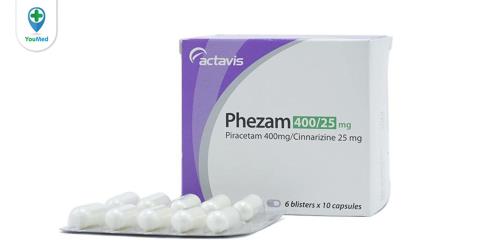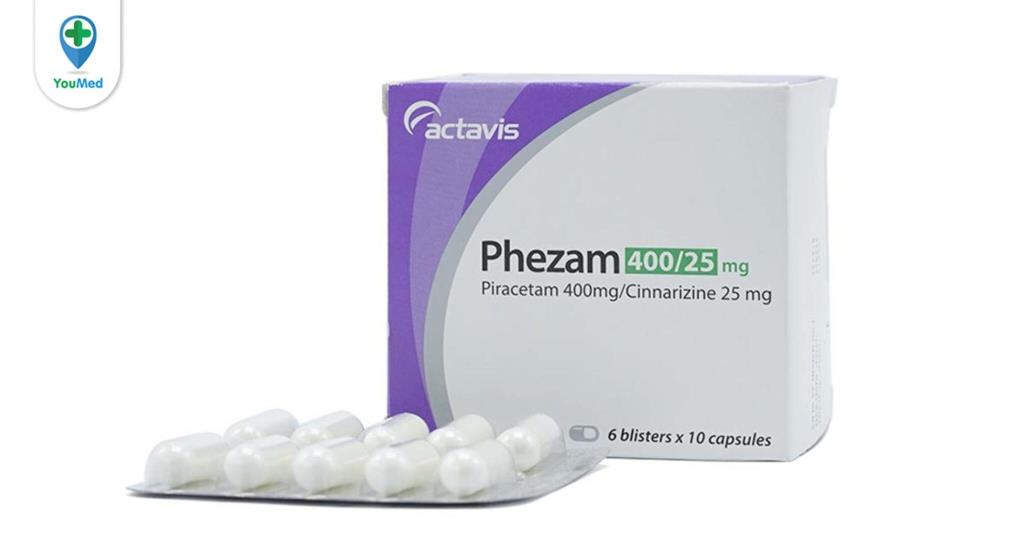What does phezam do? price, usage and things to note

What is Phezam? What is Phezam used for? What should be noted about possible side effects while taking the drug? Let's learn more about Phezam with SignsSymptomsList in the article analyzed below!
Active ingredients: piracetam, cinnarizine.
Medicines with similar ingredients: Piracefti, Spasticon, Pixcirin, Pirizatam.
content
- What is Phezam?
- How much does Phezam cost?
- What does phezam do?
- Phezam should not be used if:
- How to use Phezam effectively?
- Side effects
- Interactions that occur when taking Phezam
- Precautions while using Phezam
- Special Uses
- Treatment of Phezam overdose
- What to do when you miss a dose of Phezam
- Methods of preservation
What is Phezam?
Ingredients in the drug formula
Active:
- Piracetam: 400mg.
- Cinnarizine: 25mg.
Excipients:
- Lactose monohydrate.
- Silica colloidal anhydrous.
- Magnesium stearate.
Hard capsule composition:
- Titanium dioxide (E171).
- Gelatin.
Phezam
How much does Phezam cost?
Phezam is currently sold for about 194,000 VND/box (6 blisters x 10 tablets). However, the price will change from time to time.
What does phezam do?
- Phezam is used in the treatment of chronic cerebrovascular insufficiency and the potential risk of atherosclerosis , a condition following a stroke.
- Not only that, the drug is also used to treat post-traumatic brain failure (the period after a concussion or mild brain damage).
- In addition, Phezam also has a therapeutic effect on encephalopathy (brain damage) of various origins.
- Or Meniere's syndrome (damage to the vestibular system) with symptoms of dizziness, tinnitus, nausea, vomiting, nystagmus (involuntary eye movements).
- Note, in addition to treatment, Phezam can also help prevent motion sickness and migraines.
>> Learn more: Cebraton brain tonic: Uses, usage and notes .
Phezam should not be used if:
- Allergy to Piracetam, Cinnarizine or to any of the excipients in the formulation.
- Subjects with severe renal failure .
- In addition, the drug should not be used in subjects with hemorrhagic strokes (such as cerebral hemorrhage).
How to use Phezam effectively?
How to use
- Phezam is available in the form of a hard capsule.
- Take the tablet with a full glass of water (150-250ml).
- Note, Phezam should not be used continuously for more than 3 months.
Dosage
- Adult audience:
- Take 1-2 tablets each time.
- Should be used with a frequency of 3 times / day.
- Duration of treatment with the drug is from 1 to 3 months. This factor also depends on the severity of the disease.
- In patients with impaired renal function: Care should be taken to adjust the dose according to creatinine clearance.
- If the subject is a child:
- Dosage from 1 to 2 tablets / time.
- Number of times to use the drug: 1-2 times/day.
Side effects
- Sometimes the drug can cause gastrointestinal disorders, increased salivation, nausea, vomiting.
- Causes tremor symptoms in subjects using the drug for a long time, especially the elderly.
- Restlessness and excitement as well as sleep disturbances may also occur with the drug.
- In addition, cases of hypersensitivity reactions, skin changes, photosensitivity can also occur, but rarely.
Interactions that occur when taking Phezam
- Be careful not to drink alcohol during treatment with this medicine.
- Not only that, it is necessary to know all the drugs that you have, are or will be taking, so that the doctor can advise on effective and reasonable use of the drug.
Precautions while using Phezam
- Monitor your health carefully while using the drug. If any unusual symptoms occur, it is necessary to inform the doctor immediately.
- In patients with mild to moderate renal impairment, the therapeutic dose should be reduced or the interval between doses extended.
- For patients with liver failure: in these cases, it is necessary to monitor liver enzymes in patients who are taking the drug.
- Note in patients with glaucoma .
- Phezam should be used with caution in patients with Parkinson's disease.
Special Uses
Driving and operating machinery
- To date, there is no evidence of an effect on the ability to drive and use machines.
- Therefore, unless prescribed by a doctor, you should not arbitrarily use it to ensure safety at work as well as safety when taking drugs.
Pregnant and lactating women
- Consult your doctor or pharmacist before taking Phezam or before taking any other medication.
- In addition, the use of Phezam during pregnancy (especially during the first 3 months of pregnancy) is not recommended.
- Not only that, Piracetam is excreted in breast milk. Therefore, the drug should not be used during lactation.
>> In the first 3 months of pregnancy, pregnant mothers need to pay special attention to the baby to develop the best. Read more: 12 weeks pregnant: You're nearing the end of your first trimester .
Treatment of Phezam overdose
- If the patient accidentally takes a higher dose than prescribed: immediately contact your doctor for support and help.
- In addition, Phezam is well tolerated and in the event of an overdose there have not been adverse reactions so severe that treatment discontinuation is required.
- However, in case of overdose may cause stomach upset. In children, overdose may cause insomnia, restlessness, euphoria, irritability, tremor, rarely nightmares, hallucinations and convulsions.
- Overdose management: focus on symptomatic treatment.
What to do when you miss a dose of Phezam
- Use as soon as you remember that you have missed a dose.
- If the missed dose is close to the next dose. Skip the missed dose and follow the dosing schedule.
- Do not take a double dose to make up for the missed dose.
Methods of preservation
- Keep Phezam out of reach of children and pets.
- Store the medicine in a cool, dry place. Avoid exposure to direct light or keep the medicine in humid places.
- The best storage temperature is <>
Above is the information on the use of Phezam. Call your doctor immediately if you have any unusual symptoms so that they can be treated and supported promptly!
